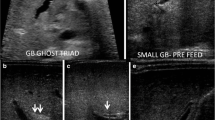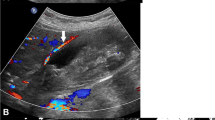Abstract
Posttraumatic bilhemia complicating liver trauma has been managed surgically so far. A case report of a biliary-venous fistula resulting from blunt hepatic trauma managed successfully by percutaneous drainage is presented. A catheter was placed in the right hepatic lobe for reducing intrahepatic pressure. This procedure was followed by a dramatic decrease of bilirubin blood level. This management emphasizes the role of interventional radiology in the treatment of complicated blunt hepatic trauma.
Similar content being viewed by others
References
Gromm E, Traumann KJ (1978). Bilhämie-Syndrome, eine seltene Komplikation nach Leberblindpunktion mit der Menghini-Nadel. DMW 34:1347.
Maxeiner H. (1984) Iatrogene biliovenöse Fistel. Z. Rechtsmed 91:235–246.
Plür S., Schwarz H (1974). Posthepatischer Ikterus nach glattem Leberdurchschuß. Helv Chir Acta 41:659–662.
Inberg MV, Ahonen J (1977) Blunt trauma to the liver and hepatic vein. A special reference to the intense postoperative conjugated hyperbilirubinemia: A case report. Acta Chir Scand, 102:428–430
Kleiber M, Bause HW (1976) Bilio-venöse Fistel als seltene Komplikation nach stumpfem Bauchtrauma. Unfallheilk 79:483–486
Sohendra N, Werner B (1977) Zur Diagnostik der traumatischen Hämobilie und Bilhämie. Dtsch Med Wochenschr 12:428–432.
Wittrin G, Clemens M, Safrany L, Schönleben K (1978) Hämobilie und Bilhämie-Komplikationen beim Lebertrauma. ZBL Chirurgie 103:1463–1470.
Enneker C, Beren JP (1978). Schwerste Leberruptur mit Lebervenenabriss und massive Bilhämie. Chirurg 48:311–314
Struyven J, Cremer M, Pirson, P, Jeanty P, Jeanmart J (1982) Posttraumatic bilhemia: Diagnosis and catheter therapy. AJR 138:746–747
Briani GF, Pederzoli P, Orcalli F, Bassi C, Abrescia F, Iacono C, Schönsberg, A, Albrigo R, Nicoli N (1983). Bilhemia: Diagnosi e trattamento conservativo a proposito di un caso complicato con ascesso epatico. Chirurgia italiana 35:965–971
Blum M, Fiedler C, Winde G, Pircher W, von Bassewitz B (1987). Die Bilhämie-ein Überblick über Diagnostik und Therapie. Chirurg 58:482–486
Author information
Authors and Affiliations
Rights and permissions
About this article
Cite this article
Blum, U., Buitrago-Tellez, C., El Seif, M. et al. Posttraumatic bilhemia: Conservative management by percutaneous drainage. Cardiovasc Intervent Radiol 16, 55–57 (1993). https://doi.org/10.1007/BF02603040
Issue Date:
DOI: https://doi.org/10.1007/BF02603040




